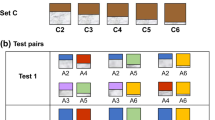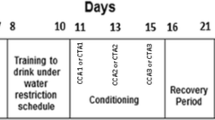Abstract
Effects of prior exposure to shape stimuli on learning of a circle/triangle discrimination task were examined in three experiments. The prior exposure given was either differentially reinforced (one of the two shapes associated with food) or nondifferentially reinforced (both shapes associated with food), with exposure given either in a similar or in a different environment (context) to the discrimination task.
In Experiment 1 albino rats were given 30-day prior exposure from age 28 days in a “same context” situation. Differentially reinforced exposure to circle/triangle or to rhombus/oval shapes enhanced learning of the discrimination task compared with controls, while nondifferentially reinforced exposure produced no significant change. In Experiment 2, Part A, brown rats given 30-day same environment differentially reinforced exposure to circle and triangle showed significantly enhanced learning of the discrimination task, but “different environment” exposure had no effect on learning. In Part B, same environment, nondifferentially reinforced exposure had no effect on task learning, but different environment exposure resulted in significant enhancement of learning. In Experiment 3 brown and albino rats were compared on discrimination performance following 15-day differentially reinforced prior exposure in the same environment to circle and triangle shapes. Although there was no difference in discrimination learning for the respective control groups, the pigmented differentially reinforced group showed significantly more enhancement of discrimination learning than did the albino differentially reinforced group. This finding appeared to be related to behavioral differences recorded during prior exposure which indicated that the albino group learned less than the pigmented group about the cue reinforcement relationship.
Similar content being viewed by others
References
ANDERSON, D.C., WOLF, D., & SULLIVAN, P. 1969. Pre-conditioning exposures to the CS: Variation in place of testing. Psychonomic Science, 14, 233–234.
BELL, J.A., & LIVESEY, P.J. 1977. The effects of prior experience with visual shapes under differing conditions of reinforcement on subsequent discrimination learning in the rat. The Psychological Record, 27, 683–691.
BENNETT, T.L., & ANTON, B.S. 1972. Critical periods for early experience in transfer of perceptual learning. Perceptual and Motor Skills, 35, 743–746.
BENNETT, T.L., ANTON. B.S., & LEVITT, L. 1971. Stimulus relevancy and transfer of perceptual learning. Psychonomic Science, 25, 159–160.
BENNETT, T.L., & ELLIS, H.L. 1968. Tactile kinesthetic feedback from manipulation of visual forms and nondifferential reinforcement in transfer of perceptual learning. Journal of Experimental Psychology, 11, 495–500.
BENNETT, T.L., RICKERT, E.J., & McALLISTER, L.E. 1970. Role of tactual-kinesthetic feedback in transfer of perceptual learning for rats with pigmented irises. Perceptual and Motor Skills, 30, 916–918.
BOLLES, R.C. 1975. Learning, motivation and cognition. In W.K. Estes (Ed.), Handbook of learning and cognitive processes. (Vol. 1), Introduction to concepts and issues. New Jersey: Lawrence Erlbaum.
BOLLES, R.C, & COLLIER, A.C. 1976. The effect of predictive cues on freezing in rats. Animal Learning and Behavior, 4, 6–8.
CROWELL, C.R., & ANDERSON, D.C. 1972. Variations in intensity, interstimulus interval, and interval between preconditioning CS exposures and conditioning with rats. Journal of Comparative and Physiological Psychology, 79, 291–298.
FELLOWS, B.J. 1967. Chance stimulus sequence for discrimination tasks. Psychological Bulletin, 67, 87–92.
FORGUS, R.H. 1956. Advantage of early over late perceptual experience in improving form discrimination. Canadian Journal of Psychology, 10, 147–155.
FORGUS, R.H. 1958a. The effect of different kinds of form pre-exposure on form discrimination learning. Journal of Comparative and Physiological Psychology, 51, 65–78.
FORGUS, R.H. 1958b. The interaction between form pre-exposure and test requirements in determining form discrimination. Journal of Comparative and Physiological Psychology, 51, 558–591.
GIBSON, E.J., & WALK, R.D. 1956. The effect of prolonged exposure to visually presented patterns on learning to discriminate them. Journal of Comparative and Physiological Psychology, 49, 239–242.
GIBSON, E.J., WALK, R.D., PICK, H.L., & TIGHE, T.J. 1958. The effect of prolonged exposure to visual patterns of learning to discriminate similar and different patterns. Journal of Comparative and Physiological Psychology, 51, 584–587.
GIBSON, E.J., WALK, R.D., & TIGHE, T.J. 1959. Enhancement and deprivation of visual stimulation during rearing as factors in visual discrimination learning. Journal of Comparative and Physiological Psychology, 52, 74–81.
GLAZER, H.L, & WEISS, J.M. 1976. Long term and transitory interference effects. Journal of Experimental Psychology: A nimal Behavior Processes, 2, 191–201.
GRANT, M., & YOUNG, D. 1971. The effects of pre-exposure to learning apparatus. Behavior Research Methods and Instrumentation, 3, 251–252.
HAYS, W.L. 1966. Statistics for psychologists. New York: Holt, Rinehart, & Winston.
KAWACHI, J. 1965. Effects of previous perceptual experience of specific three-dimensional objects on later visual discrimination behavior in rats. Japanese Psychological Research, 7, 20–28.
KERPELMAN, L.C. 1965. Pre-exposure to visually presented forms and non-differential reinforcement in perceptual learning. Journal of Experimental Psychology, 69, 257–262.
KIRK, R.E. 1968. Experimental design procedures for the behavioral sciences. Belmont: Wadsworth.
LUBOW, R.E., RIFKIN, B., & ALEK, M. 1976. The context effect: The relationship between stimulus pre-exposure and environmental pre-exposure determines subsequent learning. Journal of Experimental Psychology: Animal Behavior Processes, 2, 163–174.
MEDIN, D.L. 1975. A theory of context in discrimination learning. In G.H. Bower (Ed.), The psychology of learning and motivation (Vol. 9). New York: Academic Press.
MELLGREN, R.L., & OST, J.W.P. 1971. Discriminative stimulus pre-exposure and learning of an operant discrimination in the rat. Journal of Comparative and Physiological Psychology, 77, 179–187.
MOORE, B.R. 1973. The role of directed Pavlovian reactions in simple instrumental learning in the pigeon. In R.A. Hinde & J. Stevenson-Hinde (Eds.), Constraints on learning. London: Academic Press.
OSWALT, R.A. 1972 Relationship between level of visual pattern difficulty during rearing and subsequent discrimination learning in rats. Journal of Physiological and Comparative Psychology, 81, 122–125.
PEDEN, B.F., BROWNE, M.P., & HEARST, E. 1977. Persistent approaches to a signal for food despite food omission for approaching. Journal of Experimental Psychology: Animal Behavior Processes, 3, 377–399.
RAZRAN, G. 1971. Mind in evolution. An East-West synthesis of learned behavior and cognition. Boston: Houghton-Mifflin.
SELIGMAN, M.E.P., & MAIER, S.F. 1967. Failure to escape traumatic shock. Journal of Experimental Psychology, 74, 1–9.
STADDON, J.E.R., & SIMMELHAG, V.L. 1971. The “superstition” experiment; A reexamination of its implications for the principles of adaptive behavior. Psychological Review. 78, 3–43.
SUTHERLAND, N.S., & MACKINTOSH, N.J. 1971. Mechanisms of animal discrimination learning. New York: Academic Press.
THOMAS, D.R. 1970. Stimulus selection, attention, and related matters. In J.H. Reynierse (Ed.), Current issues in animal learning. Lincoln: University of Nebraska Press.
TOMIE, A. 1976. Retardation of autoshaping: Control by contextual stimuli. Science, 192, 1244–1246.
TOMIE, A., DAVITT, G.A., & THOMAS, D.R. 1975. Effects of stimulus similarity in discrimination training upon wavelength generalization in pigeons. Journal of Comparative and Physiological Psychology, 88, 945–954.
TRAPOLD, M.A., & OVERMIER, J.B. 1972. The second learning process in instrumental learning. In A.H. Black & W.F. Prokasy (Eds.), Classical conditioning Ii: Current research and theory. New York: Appleton-Century-Crofts.
WARREN, J.M., DERDZINSKI, D., HIRAYOSHI, I., & MUMMA, R. 1970. Some tests of attention theory with cats. In D.I. Mostofsky (Ed.), Attention: Contemporary theory and analysis. New York: Appleton-Century-Crofts.
WELKER, A.L., TOMIE, A., DAVITT, G.A., & THOMAS, D.R. 1974. Contextual stimulus control over operant responding in pigeons. Journal of Comparative and Physiological Psychology, 86, 549–562.
Author information
Authors and Affiliations
Additional information
This report is based on material that formed part of a dissertation submitted by the first author to the University of Western Australia for the degree of PhD.
Rights and permissions
About this article
Cite this article
Bell, J.A., Livesey, P.J. Cue Significance Learning From Differentially Reinforced Prior Exposure to Shape Stimuli, in Albino and Brown Rats. Psychol Rec 31, 195–220 (1981). https://doi.org/10.1007/BF03394735
Published:
Issue Date:
DOI: https://doi.org/10.1007/BF03394735




